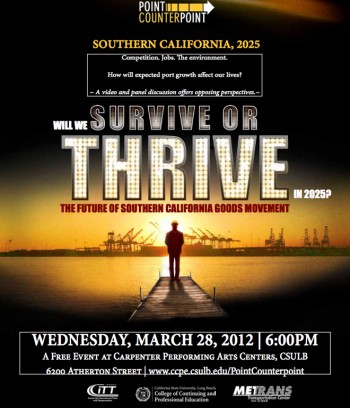
12:30pm | Last week, the Center for International Trade and Transportation (CITT) at California State University, Long Beach (CSULB) hosted the 2012 Point/Counterpoint event. Point/Counterpoint is an educational forum where experts discuss different perspectives on an issue of importance to the goods movement industry. Included in the audience were Executive Director of the Port of Long Beach, J. Christopher Lytle, Executive of the Port of Los Angeles Geraldine Knatz, and 7th District Councilmember James Johnson of Long Beach amongst others.
The question headlining the event — “Will the Southern California goods movement survive or thrive in 2025?” — was brought forth in an introduction video that simulated hypothetical possibilities. According to host Marianne Venieris, Executive Director of the CITT as well as a professor at CSULB, the hypotheticals of the video were specifically exaggerative, showing the worst and best possible scenarios.
The first version was the best outlook the Ports of Long Beach and Los Angeles could face: adapting with the times in both technology and environmental stability, each port reaches record-level TEU shipments or twenty-foot equivalent unit, an inexact unit of cargo capacity often used to describe the capacity of container ships and container terminals. Jobs flourish. Economy grows. Innovation exceeds previous levels.
The second version was much more dire: having an empty port means having empty space, where vandalism and crime skyrocket. Fires in warehouses occur. Thousands of workers lack jobs and resort to protests. Major hubs of business have vacated the area for more profitable places.
Of course, moderator Dr. Genevieve Giuliano, Senior Associate Dean of Research and Technology at the Sol Price School of Public Policy, University of Southern California and Director of METRANS Transportation Center, was quick to point out that the truth of where the goods movement within Southern California will head is probably somewhere in the middle. Her guests of panelists are some of the most powerful people in the movements industry: Mortimer Downey, Senior Advisor at Parsons Brinckerhoff; Jeannie Beckett, Principal at The Beckett Group, former Senior Economist at WSDOT Rail and Marine Office, and former Director of Operations at Port of Tacoma; and Gill V. Hicks, Senior Associate and Director of Southern California Operations at Cambridge Systematics, Inc.
The general gist expressed amongst the panelists sat somewhere between the dichotomy of pure business and pure ethics. Mr. Downey expressed a clear sentiment that the Ports have “really listened to the community” and “accordingly, the community needs to also listen [to the Port] about jobs and economic growth.” In other words, going green goes in tandem with creating jobs — but it also means sacrifices on both ends.
Many port workers in attendance, who expressed concerns on everything from cargo accessibility to cold ironing issues, were met with the usual response from all three panelists: the goods movement must keep its head above the water with regards to green technology and community forming, while keeping a “positive, strong vision” in the words of Mr. Downey. However, one port worker felt the panelists used “tokens of ideology,” especially when Mr. Hicks claimed that the recent possibility of the Terminal Island Freeway being removed would be “devastating” and contribute to the more dire version of the ports’ future — contradicting previous statements of the importance of green policies and focusing on communities which are deeply entrenched in the ports’ activities.
Despite the schism between how the ports would continue to flourish and the ways in which the outer communities will be affected by such flourishing, the engagement in conversation remains key. As a female port worker told me after the presentation, “Talking is key. We have to keep talking. They can’t make decisions without talking to the people it affects. We can’t just continue going to work expecting our jobs to stay the same.”

